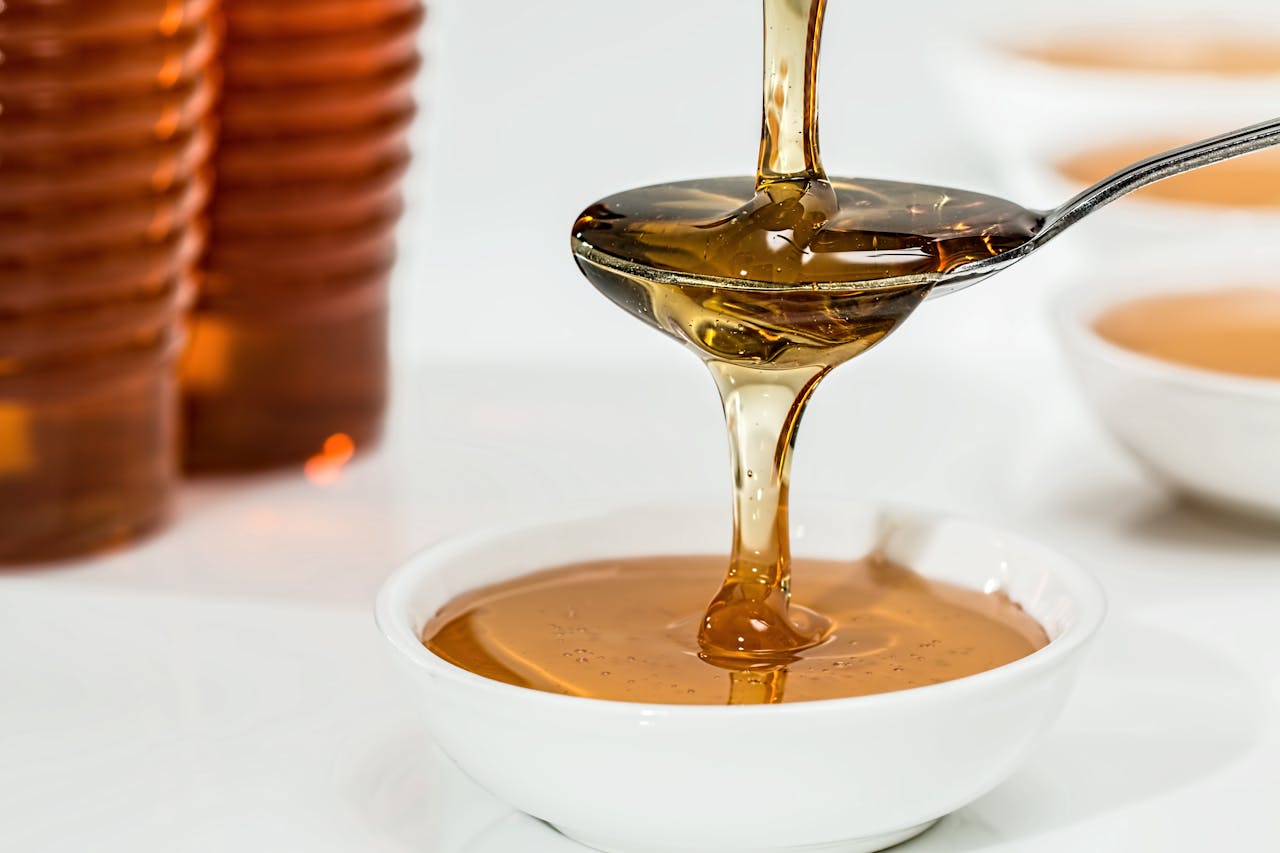Mushroom-infused honey is a delightful fusion of the earthy flavors of fungi and the natural sweetness of honey, giving rise to a unique product that is garnering attention for its taste and potential health benefits. This gourmet concoction merges the distinct characteristics of mushrooms—known for their umami—and honey, cherished for its versatile sweetness and antibacterial properties. The process involves infusing edible mushrooms into honey over a period, allowing the flavors to meld and create a harmonious blend.
As interest in natural and functional foods continues to grow, mushroom-infused honey has found a niche among health-conscious consumers and culinary enthusiasts alike. This infusion not only captures the essence of both ingredients but also leverages the bioactive compounds present in certain mushroom species, which are believed by some to provide wellness benefits. This has elevated the product from a mere sweetener to a component used in health supplements, gourmet recipes, and artisanal food products.

I am a Nurse Practitioner licensed across multiple states, with experience in cardiology, nephrology, and family medicine. My current focus is on primary care, where I advocate for a holistic approach to healthcare, often recommending functional medicine to patients when suitable.
History of Mushroom Infused Honey
The origins of combining mushrooms with honey are not well-documented, but the practice is believed to stem from the appreciation of both components’ unique properties. Historically, honey has been used for its natural sweetening characteristics and its various medicinal qualities. Mushrooms, particularly psychoactive varieties such as “magic mushrooms,” have been used for their hallucinogenic effects by various cultures for spiritual and therapeutic purposes.
- Ancient Times: It is known that psychoactive mushrooms were used in ancient civilizations. For instance, the history of psilocybin mushrooms details their use for spiritual and religious purposes in indigenous cultures.
- Medieval Period: There are anecdotal reports of honey being used as a preservative medium for various herbs and natural substances, including mushrooms.
- Modern Era: In more recent times, mushroom-infused honey has gained popularity as a gourmet item and for its potential health benefits. The use of non-psychoactive mushrooms, such as shiitake or reishi, has been explored for their nutritional and immune-boosting potential when infused with honey.
Mushroom infused honey combines the antibacterial properties of honey and the nutritional value of mushrooms. While there isn’t extensive historical documentation on this practice specifically, it is an amalgamation of the long-standing traditions of using both honey and mushrooms for their respective benefits.
Please note that while honey has a rich history which can be found in the text about Honey: A Sweet Journey Through History, the history of mushroom-infused honey as a specific practice lacks the same depth of available information. Nonetheless, it is clear that the marriage of the two is a modern take on ancient traditions surrounding these natural products.
Types of Mushrooms Suitable for Infusion
When infusing honey with mushrooms, one must select varieties known for their flavors or health benefits. The choice of mushroom affects the final taste and potential wellness qualities of the infusion.
Medicinal Mushrooms
Reishi (Ganoderma lucidum): Reputed in traditional medicine for boosting immunity and reducing stress.
Chaga (Inonotus obliquus): Often consumed for its high antioxidants and claimed to have anti-inflammatory properties.
Culinary Mushrooms
Shiitake (Lentinula edodes): These mushrooms provide a rich, umami flavor, making the infused honey savory yet slightly sweet.
Porcini (Boletus edulis): Known for their nutty taste, they can add a complex flavor profile to honey infusions.
Benefits of Mushroom Infused Honey
Mushroom infused honey combines the unique properties of fungi with the natural sweetness and benefits of honey. This specialty item merges the healthful aspects of mushrooms with honey’s well-known advantages.
Health Benefits
- Nutrient-Rich: Mushroom infused honey amalgamates the nutrients from mushrooms, like the antioxidants found in the honey mushroom variety, with the natural enzymes present in honey.
- Digestive Health: The prebiotic properties of honey may be augmented by mushrooms, presenting a potential boost to gut health and aiding in digestion.
Culinary Uses
- Flavor Enhancer: The umami flavor of mushrooms offers a complex taste dimension to honey’s sweetness, making it a versatile addition to a chef’s pantry.
- Ingredient Substitute: Mushroom infused honey can be a substitute for sweeteners in recipes, providing an added depth of flavor. For instance, honey can replace sugar in tea, incorporating the earthy tones from mushroom extracts.
Infusion Process Overview
The process of infusing honey with mushrooms involves several key steps that are executed with precision to ensure a high-quality product:
- Selection of Ingredients:
- High-quality honey and edible mushroom varieties, like shiitake or reishi, are chosen. The mushrooms should be thoroughly cleaned and dried to prevent the introduction of unwanted moisture into the honey.
- Preparation of Mushrooms:
- Mushrooms are either chopped finely or ground to increase the surface area, which allows for a more thorough infusion.
- Sterilization:
- Jars or containers used in the infusion process are sterilized to prevent contamination. This is a critical step to ensure the safety and longevity of the infused honey.
- Combining Ingredients:
- Mushrooms and honey are mixed in the sterilized container. Ratios can vary depending on the desired intensity of flavor and the specific types of mushrooms used.
- Sealing and Storage:
- The container is sealed tightly and stored in a cool, dark place to permit the infusion process. This may take several weeks to months, depending on the recipe.
- Straining:
- Once the infusion period is complete, the mixture is strained to remove mushroom solids, leaving behind the infused honey.
- Packaging:
- The final product is carefully packaged, labeled, and can be stored or refrigerated to preserve its flavors and properties.
Throughout the infusion process, it is important to maintain cleanliness and monitor the honey for signs of fermentation or spoilage. The result is a unique condiment that marries the sweetness of honey with the earthy undertones of mushrooms.
Safety and Precautions
When considering the creation of mushroom-infused honey, safety is paramount. Consumers should be informed about potential allergens and the importance of proper storage to maintain the product’s integrity and safety.
Allergen Information
It is crucial to understand that both mushrooms and honey can act as allergens for some individuals. Mushrooms may carry spores that some people are allergic to, while honey can contain pollen that also has the potential to cause allergic reactions. Anyone with a history of food allergies, especially to these two components, should consult with a healthcare provider before consumption.
- Mushroom Allergens: Potential for mold and spore allergies.
- Honey Allergens: Possible reactions due to pollen content.
Proper Storage Methods
Proper storage of mushroom-infused honey is essential to prevent spoilage and maintain its quality. Honey should be stored in a cool, dry place away from direct sunlight. Once infused with mushrooms, consider the following to preserve its safety and shelf life:
- Temperature: Store at room temperature to prevent crystallization and maintain consistency.
- Container: Use an airtight container to protect against moisture and other contaminants.
- Light Exposure: Limit exposure to light to preserve the honey’s natural properties.
Flavor Profiling and Pairings
When infusing honey with mushrooms, the unique flavor profile includes earthy, umami, and sweet notes. Mushroom-infused honey can be paired with a variety of foods to enhance the gastronomic experience.
Cheese Boards: The savory depth of mushroom honey complements the richness of cheeses such as Brie or Camembert.
- A bold blue cheese balances the sweetness and introduces a complex, creamy flavor.
- A mild goat cheese offers a tangy contrast to the honey’s rich taste.
Meats: Earthy-infused honey pairs exceptionally well with red meats.
- Drizzle over a grilled steak for a hint of sweetness and a burst of umami.
- Glaze a pork tenderloin before roasting to create a caramelized crust.
Desserts: The fusion of sweet and earthy flavors can elevate traditional desserts.
- Infused honey can be used in place of regular honey in a panna cotta for a subtle, savory twist.
- Swirl into a cheesecake filling to add a new layer of flavor complexity.
Teas and Cocktails: Mushroom-infused honey can serve as an intriguing sweetener.
- Enhance a green tea with its earthy sweetness, complementing the tea’s herbal qualities.
- Create a unique cocktail by adding a spoonful to a whiskey-based drink for a note of warmth and depth.
When experimenting with pairings, consider the mushroom variety used in the infusion and the accompanying flavor profile, whether it be subtle or pronounced. The goal is to achieve balance, allowing both the honey and the paired item to shine without overpowering each other.
DIY Mushroom Infusion Techniques
Creating mushroom-infused honey is a delicate process that requires careful sterilization and specific infusion methods to ensure a safe and flavorful result.
Sterilization Procedures
Before beginning the infusion process, one must sterilize all equipment to prevent contamination. Jars, spoons, and sieves should be thoroughly cleansed with hot water and antibacterial soap. Additionally, it might be prudent to follow a water bath canning procedure, heating the equipment in boiling water for at least 10 minutes.
Infusion Methods
For the infusion itself, one can employ a hot infusion technique or a cold infusion method, each delivering different flavor profiles and benefits.
- Hot infusion involves gently heating the honey and adding dried mushrooms, allowing the mixture to simmer at a low temperature, which should not exceed 104°F to maintain the honey’s beneficial properties.
- Cold infusion, on the other hand, requires mixing mushrooms with honey and letting the mixture sit for an extended period, often several weeks, at room temperature, which slowly infuses the honey without applying heat.
Both methods require occasional stirring to ensure even distribution of the mushroom essence throughout the honey.
Commercially Available Mushroom Honey Products
Mushroom-infused honey products merge the unique flavors of mushrooms with the natural sweetness of honey. Mushroom honey typically involves infusing various types of edible mushrooms into honey to create a product that is thought to offer potential health benefits.
Several companies offer mushroom honey products, highlighting an assortment of mushroom types, such as:
- Chaga Mushroom Honey: Touted for its antioxidant properties, Chaga mushrooms are often blended with honey to create a dark, rich spread.
- Reishi Mushroom Honey: Known for its immune-supporting potential, Reishi mushroom honey pairs the earthy tones of the Reishi with the golden sweetness of honey.
- Lion’s Mane Honey: With a focus on cognitive health, Lion’s Mane mushrooms infuse into honey for a combination believed to support mental clarity.
The table below provides a snapshot of different mushroom honey products that consumers might find on the market:
Product formulations often include raw honey to preserve natural enzymes and nutrients. Mushroom proportions vary, resulting in diverse taste profiles and consistency.
It should be noted that these products are typically gourmet and may be found in specialty food stores or online marketplaces. Pricing can fluctuate based on the rarity of the mushrooms used and the quality of the honey.
When purchasing mushroom honey, buyers are encouraged to research product reviews and select options that are transparent about their ingredient sourcing and production processes.
Regulatory Considerations
When developing and marketing mushroom-infused honey, manufacturers must navigate a complex set of regulations. These regulations are designed to ensure product safety and consumer protection.
Food Safety Standards: Both honey and mushrooms fall under the FDA Produce Safety Standards. It is crucial that manufacturers adhere to the Food Safety Modernization Act (FSMA) which requires the identification and control of potential food safety hazards. Mushroom producers, in particular, should also be aware of the ”Standards for the Growing, Harvesting, Packing, and Holding of Produce for Human Consumption” (Produce Safety Rule).
Honey Regulations: Honey production is under close surveillance to maintain quality control. Makers of mushroom-infused honey should stay informed on national honey market pricing, weather, production, bee activity, and issues related to parasites, as stated in the National Honey Report.
Labeling and Marketing Guidelines: Accurate labeling is enforced by law. Producers must ensure that their labels provide correct information about the product’s ingredients and are not misleading. Claims made about health benefits must be substantiated by credible research and comply with the related FDA regulations.
The regulatory environment is stringent but navigable. Manufacturers should implement comprehensive compliance strategies that include:
- Monitoring Regulatory Changes: Staying updated with ongoing regulatory developments.
- Product Testing: Regularly testing the product for contaminants and ensuring quality control.
- Consumer Education: Providing clear information on product usage and benefits.
By maintaining a high standard of compliance, producers can foster trust and ensure the longevity of their mushroom-infused honey products in the marketplace.
Packaging and Branding Strategies
When launching a mushroom-infused honey product, packaging and branding are crucial in distinguishing it on the shelves. Packaging should not only protect and preserve the honey but also appeal to the target demographic. Brands often opt for glass jars or bottles, which convey a premium image and are recyclable, aligning with sustainable practices.
Labeling plays a powerful role, providing a canvas for storytelling and ingredient transparency. Creative typography and nature-inspired motifs can highlight the product’s organic and artisanal features. It is vital to include descriptors like “infused with natural mushrooms” to communicate the unique selling point.
Branding extends beyond the package. A compelling brand story about sourcing, health benefits, and culinary uses can enhance customer engagement. Logos and brand colors should be consistent across all platforms for easy recognition.
Social media presence with eye-catching visuals and interactive content can attract and retain consumers. Collaborations with food bloggers and chefs can provide authentic endorsements, showcasing the versatility of mushroom-infused honey in various recipes.
In summary, effective packaging and branding require a balance between aesthetic appeal, functional design, and clear messaging to create a strong, marketable identity for mushroom-infused honey.
Marketing and Trends
The emergence of mushroom-infused honey reflects a growing demand for functional foods. Mushroom-infused honey combines the health benefits of mushrooms with the natural sweetness of honey, striking a chord with health-conscious consumers.
Market Overview:
- Consumer Awareness: Increasingly, consumers are seeking products with added health benefits, which mushroom-infused honey provides, capitalizing on the trend of superfoods.
- Retail Growth: Specialty stores and online marketplaces are expanding their product ranges to include such niche items, leading to greater shelf presence.
Trends:
- Premiumization: Consumers are willing to pay a higher price for premium products, particularly if they are perceived to have enhanced health benefits.
- Innovative Pairings: Different types of mushrooms, each with distinct health advantages, are being paired with various honey varieties to target specific consumer preferences.
Consumer Preferences:
- Health Benefits: Products that support immunity and wellness are particularly popular.
- Flavor Profiles: A balance between the unique umami of mushrooms and the sweetness of honey is key for market acceptance.
Industry Notes:
- Production and sales data, including prices and sales volume, are regularly compiled in reports such as the National Honey Report.
- Pennsylvania Mushroom Farmers are leaders in U.S. mushroom production, indicating a robust supply base for mushroom-derived products.
Conclusion: The market for mushroom-infused honey is one that leverages consumer interest in health, flavor, and sustainability. As it grows, producers and retailers are carefully observing consumer preferences and industry trends to optimize their market strategies.
Frequently Asked Questions
This section addresses common queries regarding the health benefits, preparation, storage, potential allergic reactions, types of mushrooms used, dietary incorporation, and scientific research related to mushroom-infused honey.
What are the health benefits of consuming mushroom-infused honey?
Mushroom-infused honey combines the potential health benefits of both mushrooms and honey. Honey is known for its antimicrobial properties and, depending on the mushroom species used, such as reishi or Chaga, it could provide additional antioxidant and immune-supporting effects.
How do you safely prepare and store mushroom-infused honey?
To prepare mushroom-infused honey, one should ensure that the mushrooms are properly cleaned, dried, and infused in honey under sanitary conditions. Proper storage entails keeping the honey in a cool, dry area inside a tightly covered container to prevent contamination and preserve its quality, similar to traditional honey storage practices.
Can mushroom-infused honey produce any allergic reactions?
As with any food product, individuals may experience allergic reactions to either the mushrooms or the honey in the infusion. Those with known allergies to either ingredient should avoid consumption and seek medical advice before trying new products.
What types of mushrooms are typically used for infusing honey, and why?
Typically, mushroom varieties such as reishi, lion’s mane, Chaga, and maitake are used for their unique flavors and health-promoting properties. These types are selected for their adaptogenic effects, which may support stress reduction and overall wellness.
How can mushroom-infused honey be incorporated into a daily diet?
Mushroom-infused honey can be easily incorporated into one’s diet by using it as a sweetener in tea, drizzled over yogurt or oatmeal, mixed into salad dressings, or used in marinades, providing both flavor and nutritional benefits.
Are there any scientific studies supporting the efficacy of mushroom-infused honey?
While there are numerous studies on the health benefits of mushrooms and honey individually, research specifically targeting mushroom-infused honey is less prevalent. However, the compounds within certain mushroom species and honey have been individually researched and recognized for their health-promoting properties.

